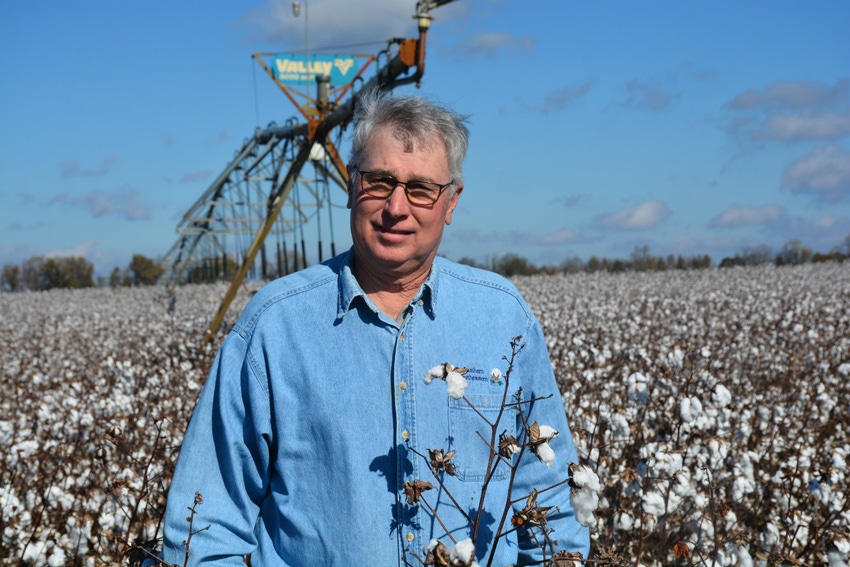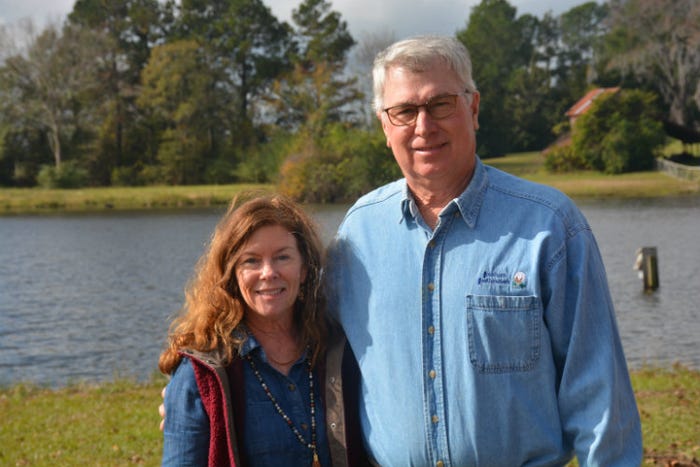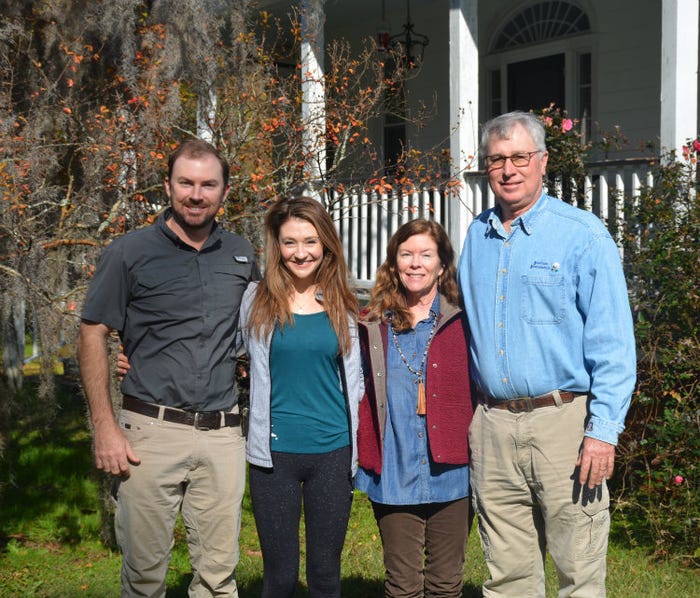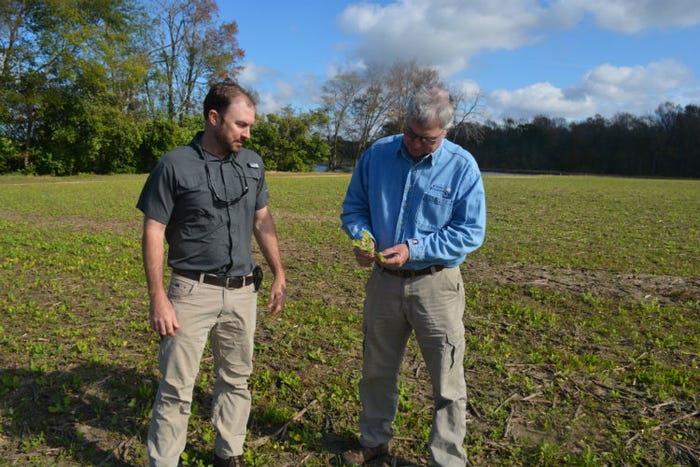
Frank B. Rogers, III, barely remembers the days of hand-picked cotton, a practice that was still being done in South Carolina when he was a very young boy. From the late 1950s to the early 1960s, cotton farmers began moving to machine-picked cotton as the industry entered a new era of innovation.
Rogers, 63, who has farmed cotton near Bennettsville, S.C., for 40 years, has seen tremendous advancements in producing cotton, and he has successfully used each of the innovations as they became available.
“I have seen the transition from labor-intensive agriculture to machine-intensive agriculture to chemical-intensive agriculture,” he says. “We are now in the technology era of agriculture, with GMOs and precision agriculture. Agriculture has advanced tremendously over the years.”
One thing is certain, Frank and his oldest son, Pat, who has farmed in partnership with his dad for 13 years, have both earned a reputation as innovators. They have been first adapters in such technology as cover crops, conservation-tillage and prescription agriculture, and both agree that innovation is a must to keep them competitive.
His success in growing cotton over the years has earned Frank the Farm Press/Cotton Foundation 2019 High Cotton award for the Southeast region. The winners, one for each region of the Cotton Belt, are nominated and chosen based on their excellence in production and stewardship. They will be recognized at an awards breakfast held in conjunction with the Mid-South Farm and Gin Show in Memphis, Tenn., March 1-2.
In nominating Rogers for the honor, fellow farmer Steve O’Neal of Blenheim, S.C., credited him as a tireless worker for the cotton industry.
“He is an outstanding farmer and innovator, and is at the cutting edge of technology on his farm. First and foremost, Frank is a southern gentleman who loves his profession and his country,” O’Neal wrote in his nomination.
FOURTH GENERATION FARMER
Rogers is a fourth generation Marlboro County farmer, having returned to the family farm in 1979 after earning a degree in agriculture economics from Clemson University. While he was a student at Clemson, Frank’s father, Frank Rogers, Jr., retired from farming, so Frank began farming on his own after graduation. Today, Frank and Pat farm a total of 6,000 acres, producing cotton, corn, soybeans, peanuts, and wheat.
Frank emphasizes that the growth to 6,000 acres did not happen overnight. “When Pat came back after graduating from Clemson in 2005, our operation was about half that size. Several retired farmers asked us if we’d be interested in taking over their land. This spoke very well of Pat — it showed their trust and confidence in someone they knew was going to be around in the years to come.”
While Frank and Pat are partners, both farm their own land independently and both make their own decisions. They do share equipment and labor to save costs, and they collaborate every step of the way. “Pat keeps his own set of books, buys his own seed and fertilizer, and markets his own crops,” Frank says. “It works out well because of mutual trust. We share labor and share equipment; this cost-sharing makes us more efficient.”
Frank considers himself first and foremost a cotton farmer. He notes that the part of South Carolina he farms is well suited for cotton, and that it is a rewarding yet challenging crop to grow. His father and earlier generations were all cotton farmers.
“In cotton, you have a crop that is adapted to the climate and the soils, and consequently it has an ability to compensate for adversity no other crop can. Cotton is drought-tolerant and it does compensate for the periods of dry weather we have. It has sustained us over the years, and it’s our desire to remain active in cotton.
LEADERSHIP POSITIONS
Rogers is a well-known and respected cotton industry leader, serving on the board of directors of Staple Cotton Cooperative Association (Staplcotn), one of the oldest and largest cotton marketing cooperatives in the United States. He is a past president of Southern Cotton Growers Association, and served as a producer director of the National Cotton Council. He currently serves as a director on the South Carolina Cotton Board.
“I really value the great work the National Cotton Council and Southern Cotton Growers do on behalf of the cotton industry. Both are so important to the health of U.S. cotton,” he says.
Frank produces 2,200 acres of cotton and 800 acres of peanuts. He notes that peanuts fit in well with cotton because of the rotational benefits. Corn is also an important part of the rotation with cotton.
In 2013, the family added irrigation and currently water about 25 percent of their best land.
“Irrigation is a challenge for us because we are not blessed with great underground water. Our wells can generate about 450 gallons per minute, while further south they generate 780 gallons per minute. Irrigation works for them, and it is one key to their success. “It gives us a good yield response with all crops,” Rogers says.
Cover crops are a vital practice for the operation, and they have used them for five years now at the suggestion of Pat. Both emphasize that cover crops work, and the response the crops show the following year is remarkable.
Pat likes an exotic multi-species cover crop tailored to both the land and the crop. When choosing a cover crop, he takes into account what the preceding crop was and what the next one will be. He uses a systems approach and looks at cover crops as a tool to increase yields. “For peanuts, we try to limit the legumes in the rotation, so our multi-species cover crops in the peanut rotation are not going to contain legumes. But if we have a corn/soybean/cotton rotation, we found that after corn we can plant a multi-species mix that is heavy on legumes,” Pat says.
“This does two things — the cover crops with legumes produce nitrogen, but they also scavenge nutrients that are out there with corn. The nutrients are available for the next crop, which is good for cotton. We’ve had good results with cover crops behind corn.”
PRECISION AGRICULTURE PRACTICES
In his cover crop mixture, Pat likes to include grasses such as black oats, wheat, and cereal rye and broadleaves like buckwheat and sunflowers. Tillage radishes are important, and for legumes, he likes vetch, winter peas, and crimson clover.
The family adopted precision agriculture practices 10 years ago, again at the suggestion of Pat. What makes it work, Frank emphasizes, is that it is all done in-house by Pat, which affords a great cost savings. “Pat does all of the sampling and uses a precision spreader to apply fertilizer. This gives us savings in both sampling and application, because he does the sampling himself and we see a great savings in fertilizer because we use less of it.”
Pat says the goal is to increase productivity on a per acre basis, while also limiting the inputs used. He says the four Rs of nutrient management work well for them: the right source at the right rate at the right time and the right place.
“We are big believers in soil sampling, and we do it by our management zones. We take soil samples every year. It’s a lot of work, but we learn a lot. I tell the guys who help me take soil samples that this is the most important job on the farm,” Pat says. After soil sampling, lime application is critical. “We apply lime to bring our soil up to the optimal pH,��” he says.
Pat considers precision agriculture an emerging frontier, and says they have just scratched the surface on what the technology can do for them. Variable rate fertilizer, variable rate seeding, and crop management zones have all worked well on the farm. “It’s a way for me to add value to the operation, and it is something I really enjoy. I like the analytical side of it, the technical side of it. There are a lot of efficiencies to be realized.”.
CLEMSON YIELD DATA
When it comes to selecting cotton varieties, Frank turns for guidance to the summation of yield data produced by Clemson Cotton Specialist Dr. Mike Jones. The data come from Georgia, North Carolina, and South Carolina, and include results from yield trials. “Mike does a spectacular job on these yield trials and they are really valuable when choosing a variety,” Frank says.
Deltapine 1646 is the No. 1 variety planted, but the family also uses a number of other varieties from both Deltapine and Phytogen. “The folks at Staplcotn love the quality and fiber length of Deltapine 1646 — it’s a good yielder and the fiber quality is excellent.”
Over the years, yields have continued to improve. A normal yield is 850 to 950 pounds per acre, and it’s not out of the question for a two-bale average. “We’ve had irrigated cotton do three bales to the acre,” Frank says. “In 2017, we averaged over two bales.”
But 2018 was a different story, due in large part to Hurricanes Florence and Michael. The Rogers farm took a direct hit from Florence, with wind damage and 16 inches of rain. Michael brought wind and six inches of rain, and rain events after Michael added another 5.5 inches.
“Our yields were all over the place,” Frank says. “We picked cotton that was 450 pounds and picked irrigated cotton that was 1,200 pounds. Our average was 750 to 800 pounds, and we consider that a great success after Florence and Michael.”
COMMUNITY SERVICE
Family and faith are important to Frank. He and wife Cheryle are active members of Thomas Memorial Baptist Church at Bennettsville, where he has been a Sunday school teacher and deacon. Frank met Cheryle, a native of Clemson, while both were students at Clemson University. Cheryle studied early childhood education and for a time taught school at Bennettsville. Today, she is a full-time farmer with Frank and Pat.
In addition to Pat, Frank and Cheryle have another son, Frankie, who owns Rogers Custom Builders in Charleston. Frankie and wife Allison have a daughter, Reese, born in August 2018, the Rogers’ first grandchild. Allison is a nurse at the South Carolina Medical University in Charleston.
Pat graduated from Clemson in 2005 with a degree in packaging science. Pat’s wife, Blake, studied graphics arts at Clemson and is a yoga instructor at Bennettsville. Frankie and Allison are also Clemson graduates. Frankie studied construction engineering and Allison studied nursing.
Frank and Pat employ five full-time workers, as well as seasonal help. They own one John Deere baler picker that Frank drives. Both father and son stress the importance of doing things yourself to manage the margins.
To market their cotton, they rely on Staplcotn. “It’s an outstanding organization, with hardworking, honest, and efficient people,” Frank says. “They do a splendid job of marketing our cotton.”
Innovation has been the key to success for Frank and Pat Rogers, and they say they will continue to innovate to succeed. So far, the timing of each has been just right.
“Mechanical picking was the right technology at the right time,” Frank says. “The John Deere baler picker was the right technology at the right time. GMOs were the right technology at the right time. Who knows what the future holds? Driverless tractors may be the next big thing.”
One thing is certain, both Frank and Pat are committed to the future of the U.S cotton industry. “We can always overcome our challenges,” Frank says, “and as long there is demand for cotton, there is a place for us in the Southeast to grow and market cotton. I am optimistic about the future.”

Frank and Cheryle Rogers met while students at Clemson University. Cheryle is a native of Clemson and studied early child education while Frank studied agricultural economics.

Pat and wife, Blake, and Frank and wife, Cheryle, are all graduates of Clemson University. Blake is a yoga instructor in Bennettsville while Cheryle is a retired school teacher and current fulltime farmer.

Pat and Frank Rogers inspect the exotic multi-species cover crop on their farm. The family began using cover crops five years ago at the suggestion of Pat.
About the Author(s)
You May Also Like






